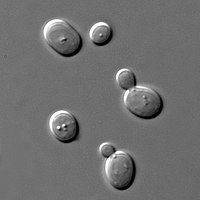
Extraction and characterization of nanocellulose crystals from cotton gin motes and cotton gin waste
Sign Up to like & getrecommendations! Published in 2019 at "Cellulose"
DOI: 10.1007/s10570-019-02533-7
Abstract: Abstract Cellulose nanocrystals (CNC) have attracted a great deal of attention as an environmentally-friendly biorenewable resource for use as reinforcing agents in nanocomposites, polymers, gels, and emulsions. CNCs are typically prepared from extracted cellulose or… read more here.
Keywords: gin motes; extraction; motes cotton; gin ... See more keywords

Criollo goats limit their grass intake in the early morning suggesting a prophylactic self-medication behaviour in a heterogeneous vegetation
Sign Up to like & getrecommendations! Published in 2019 at "Tropical Animal Health and Production"
DOI: 10.1007/s11250-019-01966-3
Abstract: The present study compared the feeding behaviour of goats in the early morning (EM = 7:00–8:30 a.m.) and late morning (LM = 9:30–11:00 a.m.) in response to their natural gastrointestinal nematode (GIN) infection status. Twelve female adult goats (37 ± 7.7 kg live weight… read more here.
Keywords: criollo goats; grass; shrubs herbs; morning ... See more keywords

Biological methods for the control of gastrointestinal nematodes.
Sign Up to like & getrecommendations! Published in 2021 at "Veterinary journal"
DOI: 10.1016/j.tvjl.2020.105602
Abstract: Gastrointestinal nematodes (GIN) are a cause of significant losses in animal production worldwide. In recent years, there have been important advances in the biological control of GIN of ruminants and horses. While these measures are… read more here.
Keywords: methods control; control; biological methods; gin ... See more keywords

Genome-wide insights on gastrointestinal nematode resistance in autochthonous Tunisian sheep
Sign Up to like & getrecommendations! Published in 2021 at "Scientific Reports"
DOI: 10.1038/s41598-021-88501-3
Abstract: Gastrointestinal nematode (GIN) infections have negative impacts on animal health, welfare and production. Information from molecular studies can highlight the underlying genetic mechanisms that enhance host resistance to GIN. However, such information often lacks for… read more here.
Keywords: autochthonous tunisian; tunisian sheep; gastrointestinal nematode; resistance ... See more keywords

Growth is impeded by gastrointestinal nematodes in weaned rather than suckling meat-breed lambs in a high summer rainfall region, on the Northern Tablelands, New South Wales
Sign Up to like & getrecommendations! Published in 2017 at "Animal Production Science"
DOI: 10.1071/an15806
Abstract: The hypothesis tested in this experiment was that the effects of gastrointestinal nematodes (GIN) on growth of meat-breed lambs would be absent during the suckling period and greatest after weaning. The experiment was a single… read more here.
Keywords: meat breed; breed lambs; gin; growth ... See more keywords

Influence of Season of Lambing on Gastrointestinal Nematode (GIN) Infection of Lambs
Sign Up to like & getrecommendations! Published in 2021 at "Journal of Animal Science"
DOI: 10.1093/jas/skab096.071
Abstract: The objective was to examine GIN infection and BW of lambs born in fall (Oct–Nov; n = 20–158/yr; n = 716 total) or winter (Jan–Feb; n = 65–208/yr; n = 1717 total). Katahdin lambs born… read more here.
Keywords: infection lambs; winter; gin infection; age ... See more keywords

12 The Efficacy of a Natural Fungus (Duddingtonia Flagrans) in Controlling Gastrointestinal Nematodes in Lactating Meat Goat Does
Sign Up to like & getrecommendations! Published in 2023 at "Journal of Animal Science"
DOI: 10.1093/jas/skad068.143
Abstract: Small ruminant production in the US is significantly impacted by infections with gastrointestinal nematodes (GIN), especially the blood sucking GIN, Haemonchus contortus. Unfortunately, the indiscriminate use of available drug classes has led to multi-drug resistant… read more here.
Keywords: gastrointestinal nematodes; natural fungus; duddingtonia flagrans; gin ... See more keywords

The mechanism of knowledge management process toward minimizing technical risks under green implementation network: a direct and configurational approach
Sign Up to like & getrecommendations! Published in 2023 at "Journal of Manufacturing Technology Management"
DOI: 10.1108/jmtm-03-2023-0085
Abstract: PurposeThe knowledge management (KM) sharing process plays an essential role in manufacturing under Green Implementation Network (GIN). This study aims to analyze the KM process of adopting a GIN to determine the relative importance of… read more here.
Keywords: minimizing technical; gin; technical risk; management ... See more keywords